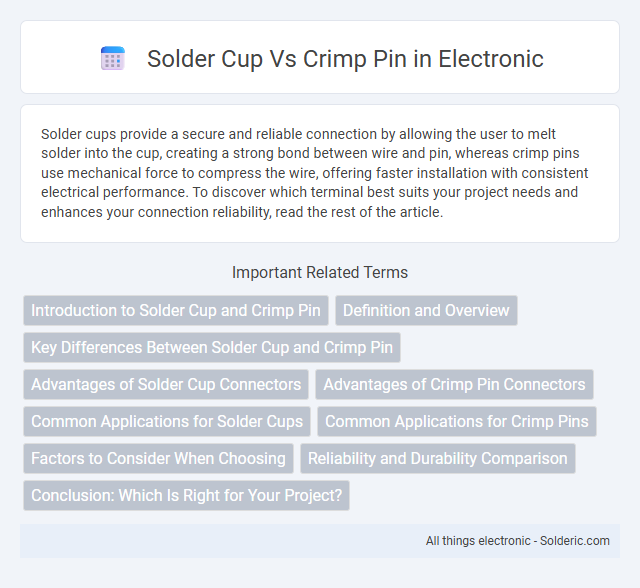Solder cups provide a secure and reliable connection by allowing the user to melt solder into the cup, creating a strong bond between wire and pin, whereas crimp pins use mechanical force to compress the wire, offering faster installation with consistent electrical performance. To discover which terminal best suits your project needs and enhances your connection reliability, read the rest of the article.
Comparison Table
| Feature | Solder Cup | Crimp Pin |
|---|---|---|
| Connection Method | Soldering wire to cup terminal | Crimping wire using special tool |
| Installation Time | Longer due to soldering process | Faster with proper crimping tool |
| Reliability | Strong, but solder joints can fail under stress | High mechanical strength, less prone to failure |
| Tool Requirement | Soldering iron and solder | Crimping tool specific to pin size |
| Rework | Easier by reheating solder joint | Requires cutting and re-crimping wire |
| Application | Prototyping, low volume, or manual assembly | High volume production, automotive, aerospace |
| Cost | Lower initial cost, higher labor cost | Higher initial cost (tools), lower labor cost |
Introduction to Solder Cup and Crimp Pin
Solder cups and crimp pins are two common types of electrical connectors used for securing wires to terminals. A solder cup features a small cavity designed to hold solder and wire, creating a strong mechanical and electrical bond through melting solder. Crimp pins rely on a specialized tool to deform the connector around the wire, ensuring a secure, gas-tight connection without the need for heat.
Definition and Overview
Solder cups are small, hollow connectors designed to receive stripped wire ends, allowing for a secure electrical connection through soldering, ensuring strong mechanical and conductive bonds. Crimp pins, by contrast, are metal terminals that create connections by mechanically compressing and deforming the wire strands inside a specially designed barrel for reliable conductivity without solder. Both solder cups and crimp pins are widely used in electronics and wiring harnesses, offering distinct advantages depending on assembly requirements, with solder cups favoring precision soldered joints and crimp pins emphasizing speed and consistency in mass production.
Key Differences Between Solder Cup and Crimp Pin
Solder cup connectors rely on molten solder to create a strong, durable electrical bond by filling a small cup with solder, providing excellent conductivity and resistance to vibration. Crimp pins use a mechanical connection where the wire is firmly compressed by a crimping tool, ensuring quick installation and reliable strain relief without the heat required for soldering. Your choice between solder cup and crimp pin depends on factors such as environmental conditions, required durability, and installation speed.
Advantages of Solder Cup Connectors
Solder cup connectors provide superior electrical conductivity and mechanical strength due to the secure solder joint, enhancing signal integrity and durability in high-vibration environments. They offer flexibility in wire gauge compatibility and allow for easy inspection and repair, reducing maintenance time and cost. The robust connection minimizes signal loss and ensures reliable performance in critical applications such as aerospace and industrial automation.
Advantages of Crimp Pin Connectors
Crimp pin connectors offer superior mechanical strength and vibration resistance compared to solder cup connections, ensuring reliable signal integrity in demanding environments. Their installation process is faster and more consistent, reducing labor costs and minimizing the risk of cold solder joints that can cause electrical failures. These connectors also provide excellent environmental protection and are well-suited for automated assembly lines, enhancing overall production efficiency.
Common Applications for Solder Cups
Solder cups are commonly used in aerospace, military, and high-reliability electronics where secure, electrically robust connections are essential. These soldered joints provide excellent mechanical strength and reliable conductivity, making them ideal for connectors in harsh environments and critical signal transmission. Crimp pins, while faster to assemble, are less favored in applications demanding the precision and durability offered by solder cups.
Common Applications for Crimp Pins
Crimp pins are widely used in automotive wiring harnesses, aerospace connectors, and industrial machinery due to their reliability and quick installation. Their ability to maintain strong electrical connections under vibration and mechanical stress makes them ideal for high-performance and safety-critical applications. You can trust crimp pins for consistent conductivity and ease of maintenance in complex wiring systems.
Factors to Consider When Choosing
When choosing between solder cup and crimp pin connectors, consider factors such as mechanical strength, ease of installation, and environmental resistance. Solder cup connectors provide superior electrical conductivity and reliability in high-vibration settings, while crimp pins offer faster assembly and consistent performance in mass production. Ensuring compatibility with cable types and application requirements will optimize your connection's durability and efficiency.
Reliability and Durability Comparison
Solder cup connections provide superior electrical reliability due to a solid, corrosion-resistant bond formed by the solder, ensuring stable conductivity over time under varying environmental conditions. Crimp pins offer excellent mechanical durability and resistance to vibration, as the crimping process creates a tight, gas-tight seal that maintains consistent contact without solder fatigue. When comparing reliability and durability, solder cups excel in long-term electrical integrity, while crimp pins are favored for robust mechanical performance in dynamic applications.
Conclusion: Which Is Right for Your Project?
Choosing between solder cup and crimp pin connectors depends on factors such as durability, ease of assembly, and application environment. Solder cups offer strong, reliable electrical connections ideal for high-vibration settings, but require soldering skills and equipment, whereas crimp pins provide faster assembly with consistent mechanical strength suited for large-scale manufacturing. Assessing project requirements like volume, connector performance, and available tools will determine the optimal connector type for your application.
Solder cup vs Crimp pin Infographic

 solderic.com
solderic.com